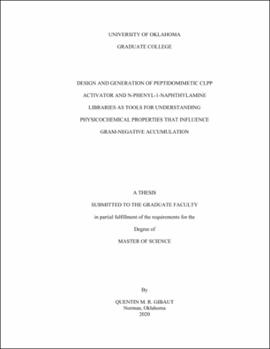| dc.description.abstract | Gram-negative bacteria pose a major threat to human health as they demonstrate low sensitivity to most antibiotics. This lack of sensitivity to antimicrobials is largely due to the amphipathic membrane architecture and efficient efflux pumps. Additionally, antibiotics have been overused, which increases the prevalence of multidrug-resistant pathogens and thus, less efficient antibiotics. For these reasons, the need for broad- spectrum antibiotics has never been more important. In the early 1980s, a new class of antibiotics based on the natural product acyldepsipeptide (ADEP) was discovered. ADEPs target the well-conserved bacterial protease caseinolytic protease P (ClpP). Overactivation of this protease leads to uncontrolled protein degradation and, in many cases, cell death. However, the membrane-permeability and susceptibility to efflux preclude the use of ADEPs to target Gram-negative bacteria. Unfortunately, a lack of understanding exists for how to rationally “design in” Gram-negative activity and thus it remains very difficult to improve the spectrum of known chemotypes.
Related to the aforementioned challenges, we have a research program focused on elucidating which physicochemical properties of small molecules influence Gram- negative membrane-permeation and, in turn, intracellular small molecule accumulation. As part of this initiative, we synthesized two libraries, 1) a peptidomimetic library of putative ClpP activators based on the ADEP pharmacophore and 2) a library based on the fluorescent probe N-phenyl-1-naphthylamine (NPN). In total, 46 new peptidomimetic analogues and 57 NPN derivatives were synthesized. During the construction of these libraries two new applications for the reagent DABAL-Me3 were developed. In addition, all compounds were assessed for minimum inhibitory concentrations against wild-type and compromised Gram-negative bacterial strains. The 103 compounds synthesized in this work represent an important component of a larger collaborative effort to determine molecular features and species-specific biology that dictate small molecule accumulation. Completion of these libraries sets the stage for incorporation into larger scale cheminformatics, accumulation assessments, and kinetic modelling of permeation and accumulation parameters. | en_US |
